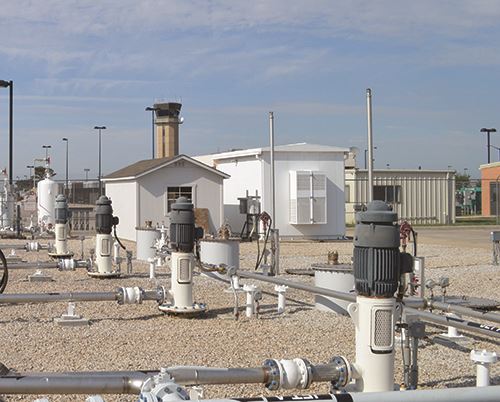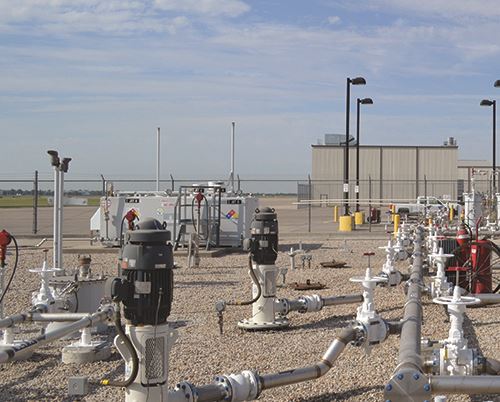A $5.6 million project to upgrade fuel farm infrastructure at Wichita Dwight D. Eisenhower National Airport (ICT) in Kansas was completed this summer without any disruption to operations. The project included phased repairs and upgrades to six 25,000-gallon underground tanks that store jet fuel as well as other system improvements.
A $5.6 million project to upgrade fuel farm infrastructure at Wichita Dwight D. Eisenhower National Airport (ICT) in Kansas was completed this summer without any disruption to operations.
 The project included phased repairs and upgrades to six 25,000-gallon underground tanks that store jet fuel as well as other system improvements. In the future, the airport will upgrade and convert two other 25,000-gallon tanks from Avgas for smaller piston-powered aircraft to jet fuel.
The project included phased repairs and upgrades to six 25,000-gallon underground tanks that store jet fuel as well as other system improvements. In the future, the airport will upgrade and convert two other 25,000-gallon tanks from Avgas for smaller piston-powered aircraft to jet fuel.
Rick Stone, the airport’s environmental services manager, explains that adding 50,000 more gallons of storage capacity for jet fuel will position ICT for future growth and ease concerns from airlines about maintaining enough fuel to continue flight service in the event of supply disruptions.
Work on the six jet fuel tanks began in late 2019. COVID-19 stymied progress by driving up project costs while also significantly reducing revenue from fuel sales. As such, airport officials have delayed plans to convert the two Avgas tanks—work that was originally scheduled to occur with the other upgrades.
|
facts&figures Project: Fuel Farm Upgrades Location: Wichita Dwight D. Eisenhower Nat’l Airport in KS Airport Owner/Operator: Wichita Airport Authority 2021 Passenger Volume: Nearly 1.3 million Project Cost: $5.6 million Funding: General airport revenue Timeline: Late 2019-June 2022 Prime Contractor: KEAR Civil Corp. Project Engineer: Currier & Company Inc. Tank Subcontractor: Piping & Equipment Co. Tank Lining Subcontractor: Thomas Industrial Coatings Control Building Subcontractor: Conco Construction Fuel Farm Operator: Signature Flight Support Work Scope: Line bottom half of six underground fuel storage tanks with a protective epoxy coating; replace pipe systems; upgrade internal components; construct new control building; install new control system Key Benefits: Maintains compliance with environmental regulations; increases efficiency of fuel farm operations; increases on-site fuel reserves; positions airport to add more carriers/service |
“COVID hit us hard, so we decided to concentrate on the six jet fuel tanks first,” Stone explains. “We sell an average of 42,000 gallons of fuel a day, so our goal was to keep four tanks operational during the project, just to be sure we had more than enough fuel on hand to service normal airline traffic.”
“This was the largest upgrade ever to the facility and took considerable coordination and phasing,” he adds. “It was very detailed because we made a lot of changes and had to keep the fuel farm open. It was a bit of balancing act.”
With 3,234 acres of land and service from six airlines, ICT is the largest and busiest airport in Kansas. Last year, the three-runway airfield served nearly 1.3 million passengers.
System Makeover
A main component of the project, designed by Currier & Company Inc., involved lining the bottom half of the steel tank interiors with a protective epoxy coating to prevent corrosion. Piping & Equipment Co. in Wichita performed the tank repairs and upgrades; Thomas Industrial Coatings handled the epoxy-coating process.
“It was getting to the point where the infrastructure was getting old,” Stone explains, noting the fuel farm was built in 1965 and has undergone several minor upgrades since then.
Before lining the tanks, crews cleaned and sandblasted them to remove the existing lining to assess the condition of the steel. Four of the six tanks required structural strengthening.
Basically, it was an overall upgrade, including improvements to tank accessories such as floating suction arms, stainless-steel internal ladders, brackets and supports, etc. Crews also installed new pipes, upgraded the fuel dispensing system, rehabilitated the system’s pumps, added a new control system and constructed a 600-square-foot control building to replace a much smaller and older facility.
Previously, airline personnel who regularly visit the facility didn’t have a place to complete their paperwork. “Now we have a small conference area for auditors as well as upgraded integration controls for farm operation,” says Stone.
Planning and Coordination
Upgrading fuel farms is a complex and tricky process that involves a lot of detailed planning and coordination, says Mike Fossett, president of prime contractor KEAR Civil Corp., which managed the project.
“Sometimes the projects carry a higher risk and require a fuel system shut down,” Fossett remarks. “But with this project, we were able to phase the work and install the new tie-ins without discontinuing service.
 “It’s very technical work,” he continues. “It’s like replacing the nervous system of the facility, but you have to keep the heart pumping and the blood flowing.”
“It’s very technical work,” he continues. “It’s like replacing the nervous system of the facility, but you have to keep the heart pumping and the blood flowing.”
Fossett emphasizes that contractors have to understand how fuel farms work to phase projects to meet design requirements and still maintain operations during construction. “Planes don’t wait,” he comments. “They have to fly.”
At ICT, jet fuel isn’t delivered by trucks. Instead, it’s supplied by a 24-mile pipeline that runs from an oil company holding facility.
“There was nothing else out here when the airport was built in 1954,” Stone notes. “There was no infrastructure; no roads for fuel trucks to get in and out. So a pipeline made sense at the time.
“We’re fortunate to have it because fuel trucks create a lot of wear and tear on roads.”

Successful Endeavor
Stone praises the teamwork and skill of the contractors that worked on the project, as well as cooperation from Signature Flight Support, the fixed base operator that manages the fuel farm under the supervision of Terry Bottoms.
“The project went very well and everyone involved did a great job,” says Stone.
Fossett highlights the importance of effective planning, phasing and design.
“The upgraded system gives the airport the storage and regulatory compliance it needs,” he adds. “The new system should meet the airport’s demands for years to come.”
If all goes as planned, the two now-empty Avgas storage tanks will be converted to jet-fuel tanks within the next few years. The conversion will be more complicated than the recent upgrades to the other six tanks because the Avgas tanks weren’t designed to store and dispense jet fuel.
“It will take a little longer because the tanks will require the installation of additional components,” Stone says.

Getting the Lead Out
Airport officials decided to stop selling fuel for piston aircraft in 2017 because of the increasing liabilities linked to disposing Avgas if it ever degrades.
“Disposal regulations keep getting stricter because of the fuel’s lead content,” Stone explains. “Plus, we didn’t sell a lot of it anyway, and one of our FBOs now supplies Avgas.”
The upgraded fuel farm positions ICT to accommodate more commercial airlines and also eases concerns from current carriers about maintaining adequate on-site fuel reserves.
“It’s something the carriers wanted,” Stone says. “If the pipeline would ever go down, they would like a bigger buffer there and an additional 50,000 gallons of capacity will give us that bigger buffer.
“More fuel storage capacity also will position us for further growth,” he adds. “We hope to get more carriers and they’ll all need fuel.”



